- Regulatory Status
- RUO
- Other Names
- CTSB, CPSB, APP secretase, APPS, Cathepsin B1
- Ave. Rating
- Submit a Review
- Product Citations
- 4 publications
| Cat # | Size | Price | Quantity Check Availability | Save | ||
|---|---|---|---|---|---|---|
| 557708 | 500 µg | 2808€ | ||||
| 557702 | 10 µg | 179€ | ||||
| 557704 | 25 µg | 352€ | ||||
Cathepsin B (CTSB) is a lysosomal cysteine protease. While most cathepsins are exclusively endopeptidases, CTSB exhibits both carboxypeptidase and endopeptidase activities. The optimal pH for CTSB activity is between four and six. Cystatin C has been identified as an endogenous CTSB inhibitor. High CTSB protein levels and activities have been found in many tumors including breast, cervix, colon, stomach, glioma, lung, and thyroid tumors. CTSB can be secreted by tumor cells and is associated with the cell membrane of these cells. Membrane associated CTSB promotes extracellular matrix (ECM) degradation contributing to cancer motility and invasion. Many ECM proteins, including laminin, fibronectin, and collagen IV, are substrates of CTSB. CTSB can also activate pro-uPA/PLAU. Activated uPA promotes ECM digestion through serine protease plasminogen. It has been shown that the inhibition of CTSB can limit bone metastasis in breast cancer, making it an important anti-cancer drug target. CTSB has been proposed as a new drug target for Alzheimer's disease because of its involvement in the production of neurotoxic β-amyloid (Aβ) peptides. The inhibition of CTSB can reduce the brain Aβ peptides and improve memory determined from a mouse model with Alzheimer's disease. CTSB also plays significant roles in immune responses including both T and B cell apoptosis and Th1/Th2 polarization. CTSB is implicated in other pathological conditions including cardiovascular disease, multiple sclerosis, and arthritis. Roles of CTSB in autophagy, adipogenesis, and cholesterol absorption in the intestine have also been studied.
Product DetailsProduct Details
- Source
- Human Cathepsin B, amino acids (Arg18 -Ile339) (Accession# NP_001899.1), with a C-terminal 10-His tag was expressed in 293E cells.
- Molecular Mass
- The 332 amino acid recombinant protein has a predicted molecular mass of approximately 37 kD. The DTT-reduced and non-reduced protein migrate at approximately 45 kD by SDS-PAGE. The predicted N-terminal amino acid is Arg.
- Purity
- >95%, as determined by Coomassie stained SDS-PAGE under reducing conditions
- Formulation
- 0.22µm filtered protein solution is in 20 mM Tris, 100 mM NaCl, and pH 8.0.
- Endotoxin Level
- Less than 0.01ng per µg cytokine, as determined by the LAL method.
- Concentration
- 10 and 25 µg sizes are bottled at 200 µg/mL. 100 µg size and larger sizes are lot-specific and bottled at the concentration indicated on the vial. To obtain lot-specific concentration and expiration, please enter the lot number in our Certificate of Analysis online tool.
- Storage & Handling
- Unopened vial can be stored at -20°C for one month, or at -70°C for six months. For maximum results, quick spin vial prior to opening. Avoid repeated freeze/thaw cycles.
- Activity
- The activity of CTSB is determined by its ability to cleave the fluorogenic peptide substrate, Z-Leu-Arg-AMC (Z=Benzyloxycarbonyl, AMC=7-amino-4-methylcoumarin) after stimulation. The specific activity is >2,500 pmol/min/µg.
- Application
-
Bioassay
- Application Notes
-
BioLegend carrier-free recombinant proteins provided in liquid format are shipped on blue-ice. Our comparison testing data indicates that when handled and stored as recommended, the liquid format has equal or better stability and shelf-life compared to commercially available lyophilized proteins after reconstitution. Our liquid proteins are verified in-house to maintain activity after shipping on blue ice and are backed by our 100% satisfaction guarantee. If you have any concerns, contact us at tech@biolegend.com.
- Product Citations
-
Antigen Details
- Structure
- Cysteine protease.
- Distribution
-
CTSB is ubiquitous expressed and is normally localized to lysosomes. However, it can also be secreted by many cells including tumor cells, macrophages, fibroblasts, osteoclasts, T lymphocytes, and neutrophils.
- Function
- Cathepsin B is a lysosomal cysteine protease that is normally involved in intracellular protein turnover.
- Interaction
- Interacts with Hepatitis B spliced protein, Bikunin, and TSRC1.
- Biology Area
- Apoptosis/Tumor Suppressors/Cell Death, Cell Biology, Neurodegeneration, Neuroscience, Neuroscience Cell Markers, Protein Trafficking and Clearance, Stem Cells
- Molecular Family
- Enzymes and Regulators, Lysosomal Markers
- Antigen References
-
1. Mohamed MM and Sloane BF. 2006. Nat. Rev. Cancer. 6:764.
2. Wang C, et al. 2012. J. Biol. Chem. 47:39834.
3. Grzonka Z, et al. 2001. Acta Biochim. Pol. 48:1.
4. Liu J, et al. 2006. FEBS Letters 580:245.
5. Brix K, et al. 2008. Biochimie. 90:194.
6. Turk V, et al. 2012. Biochim. Biophys. Acta. 1824:68. - Gene ID
- 1508 View all products for this Gene ID
- UniProt
- View information about Cathepsin B on UniProt.org
Related FAQs
- Why choose BioLegend recombinant proteins?
-
• Each lot of product is quality-tested for bioactivity as indicated on the data sheet.
• Greater than 95% Purity or higher, tested on every lot of product.
• 100% Satisfaction Guarantee for quality performance, stability, and consistency.
• Ready-to-use liquid format saves time and reduces challenges associated with reconstitution.
• Bulk and customization available. Contact us.
• Learn more about our Recombinant Proteins. - How does the activity of your recombinant proteins compare to competitors?
-
We quality control each and every lot of recombinant protein. Not only do we check its bioactivity, but we also compare it against other commercially available recombinant proteins. We make sure each recombinant protein’s activity is at least as good as or better than the competition’s. In order to provide you with the best possible product, we ensure that our testing process is rigorous and thorough. If you’re curious and eager to make the switch to BioLegend recombinants, contact your sales representative today!
- What is the specific activity or ED50 of my recombinant protein?
-
The specific activity range of the protein is indicated on the product datasheets. Because the exact activity values on a per unit basis can largely fluctuate depending on a number of factors, including the nature of the assay, cell density, age of cells/passage number, culture media used, and end user technique, the specific activity is best defined as a range and we guarantee the specific activity of all our lots will be within the range indicated on the datasheet. Please note this only applies to recombinants labeled for use in bioassays. ELISA standard recombinant proteins are not recommended for bioassay usage as they are not tested for these applications.
- Have your recombinants been tested for stability?
-
Our testing shows that the recombinant proteins are able to withstand room temperature for a week without losing activity. In addition the recombinant proteins were also found to withstand four cycles of freeze and thaw without losing activity.
- Does specific activity of a recombinant protein vary between lots?
-
Specific activity will vary for each lot and for the type of experiment that is done to validate it, but all passed lots will have activity within the established ED50 range for the product and we guarantee that our products will have lot-to-lot consistency. Please conduct an experiment-specific validation to find the optimal ED50 for your system.
- How do you convert activity as an ED50 in ng/ml to a specific activity in Units/mg?
-
Use formula Specific activity (Units/mg) = 10^6/ ED50 (ng/mL)

 Login / Register
Login / Register 



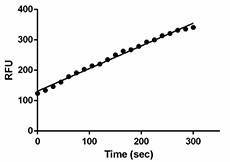






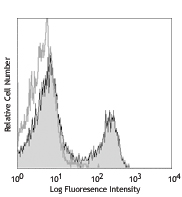
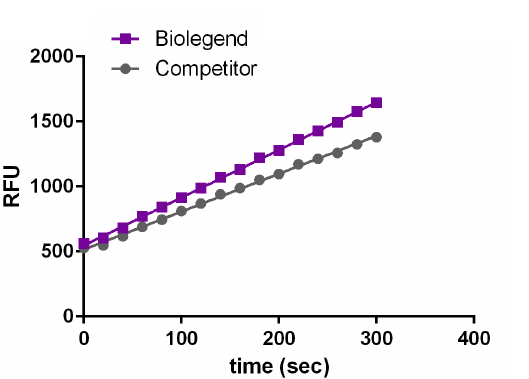
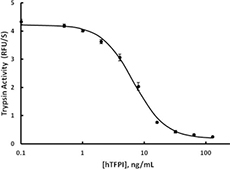
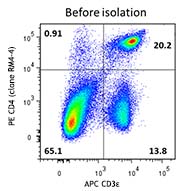







Follow Us